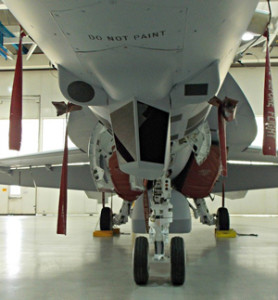
The Boeing Company and its F/A-18E/F program partner Northrop Grumman have recently completed the first series of flight-testing an advanced version of the Super Hornet multirole strike fighter. According to Boeing, the tests demonstrated that the fighter could outperform threats for decades to come, with improvements that make the jet much harder for radar to detect and give it significantly more combat range. The first of 21 flight tests began August 5th. The tests were conducted at St Louis and Patuxent River, over a period of 3 weeks. On these flights the team tested the aircraft with non-functional Conformal Fuel tanks (CFT) and an Enclosed Weapons Pod (EWP) models, and signature enhancements, enabling the validation of radar cross-section reduction and comparing the drag count to wind tunnel and simulation models. After validation, functional CFT/EWPs will be able to retrofit on existing Super Hornet Block II aircraft or included on new jets. These flight tests will provide the F/A-18 industry team with valuable data on flying qualities, drag and signature levels.
More editorial available to members.
The tests also showed that the CFTs increase the jet’s combat radius by up to 130 nautical miles, for a total combat radius of more than 700 nautical miles. “Even though we added components to the aircraft, their stealthy, low-drag design will enhance the combat capability and survivability of the Super Hornet on an aircraft that has a combat-proven history launching and recovering from aircraft carriers,” said Mike Wallace, the Boeing F/A-18 test pilot who flew the Advanced Super Hornet configuration. One of the major contributors to the fighter’s new stealth features is the EWP. Combining all stealth features, these signature enhancements result in a 50 percent reduction compared with the U.S. Navy’s stealth requirement for the current Super Hornet variant. “The improvements will ensure that the Advanced Super Hornet outpaces enemy aircraft and defenses through 2030 and beyond, especially when that enemy tries to deny access to a specific area, such as skies over international waters near its assets.” Boeing official commented.

The enclosed weapons pod is designed to allow the Super Hornet to reduce its RCS while carrying a meaningful munitions load. One pod is able to carry both six small diameter bombs and two advanced medium-range air-to-air missiles (AMRAAMs); or two 500 lb Paveways laser guided bombs and two AMRAAMs; or an equivalent load up to 2,600 lb (1,179 kg).
 By replacing underwing drop tanks with low profile, conformal containers, the CFT add to the fighters’ mission endurance by adding fuel, reducing drag and eliminating the undwering drop tanks that further improve the aircraft low-observability. Employing rapid prototyping processes, Northrop Grumman completed the design and assembly of the conformal tanks in less than 10 months. Both the F/A-18 and its electronic attack variant, the EA-18G, will benefit from these conformal fuel tanks. The tanks, which are added to the upper fuselage of the aircraft, accommodate up to 3,500 pounds of additional fuel.
By replacing underwing drop tanks with low profile, conformal containers, the CFT add to the fighters’ mission endurance by adding fuel, reducing drag and eliminating the undwering drop tanks that further improve the aircraft low-observability. Employing rapid prototyping processes, Northrop Grumman completed the design and assembly of the conformal tanks in less than 10 months. Both the F/A-18 and its electronic attack variant, the EA-18G, will benefit from these conformal fuel tanks. The tanks, which are added to the upper fuselage of the aircraft, accommodate up to 3,500 pounds of additional fuel.

For a typical strike mission, a Super Hornet or Growler with CFT can increase its unrefueled strike radius by 118 to 134 nautical miles, or increase its station time by more than 30 minutes. For the EA-18G aircraft, the tanks also provide enhanced capabilities when operating from an aircraft carrier by reducing overall weight. By removing the underwing drop tanks the CFT also improves the F/A-18G Growler efficiency by allowing electronic jammers a greater field of operations.
CFT and EWP are two elements on a list of optional improvements that form the ASH upgrade package proposed by Boeing, sustaining the Super Hornet through the 2030s. The list also includes enhanced performance versions of the General Electric F414-440 engines that boost the thrust by 20 percent, introduction of full spherical missile warning capability, an advanced cockpit employing large area displays and internal Infrared Search-Track (IRST) system.


















